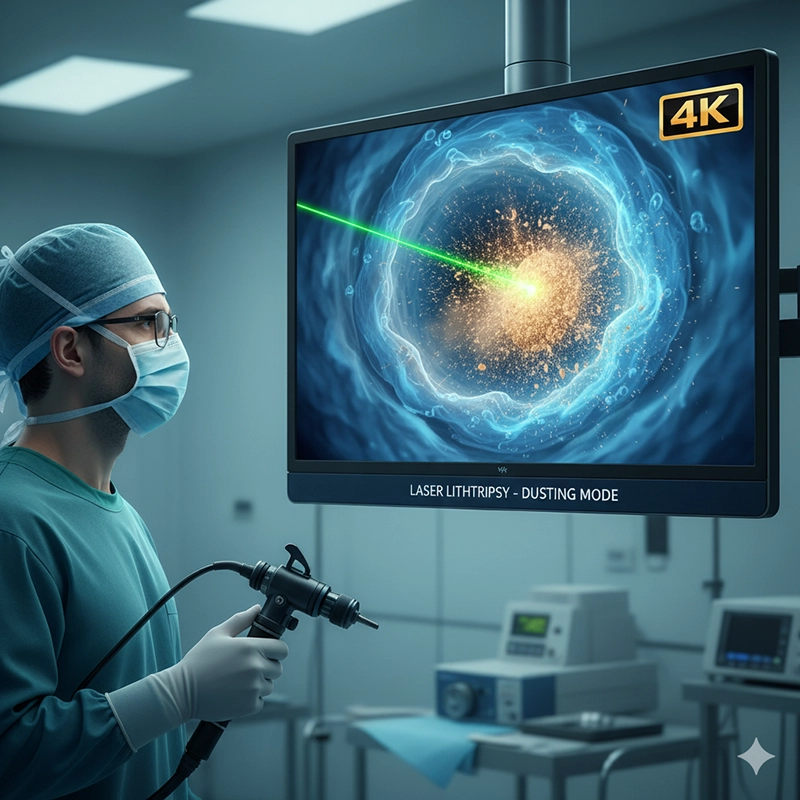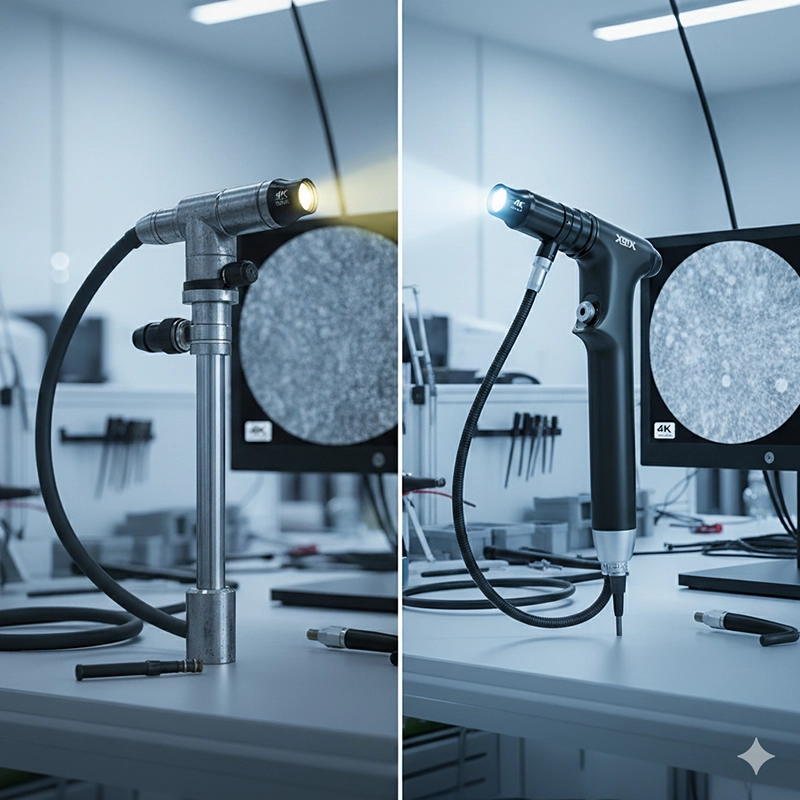Table of Contents
Not long ago, stone surgery meant stiff scopes, dim lighting, and a lot of guesswork. Urologists had to fight glare, awkward torque, and narrow views while navigating fragile ureters. Today, the XBX flexible ureteroscope for stone removal feels like a different instrument entirely—lighter in the hand, clearer on the screen, and more forgiving inside delicate anatomy. So yes, the experience has changed, and the reason is simple: precision manufacturing finally caught up with clinical reality.
The first minute of any ureteroscopy sets the tone. With older scopes, insertion could feel tentative—too much resistance and you worried about trauma, too little control and you lost your orientation. The XBX flexible ureteroscope stabilizes that moment. Its slimmer shaft, smoother jacket, and balanced handle put the tip where the surgeon intends. Here’s why that matters: initial alignment determines whether access to the kidney calyx is gentle or frustrating. With XBX, the glide is predictable, and the view arrives sooner.
Ergonomic handle geometry reduces wrist strain during long lithotripsy sessions.
Optimized rotation friction lets the tip “settle” rather than snap, aiding delicate calyx entry.
Button placement supports one-handed capture, irrigation, and laser-ready positioning.
In short, control stops being a barrier and becomes a quiet confidence that carries through the entire case.
Stone surgery depends on reliable vision in tight, fluid-filled spaces. The XBX flexible ureteroscope pairs a high-sensitivity digital sensor with calibrated LED illumination so crystals, mucosa, and micro-fragments remain visible even when the field turns murky. So yes, chips and dust still happen—but edge contrast stays usable, and color remains honest.
4K-ready processing preserves fine texture on stone surfaces, helping target laser energy efficiently.
Balanced color science differentiates urothelium from blood-tinged fluid, limiting misjudged movements.
Anti-fog, anti-glare distal optics keep the frame stable when irrigation surges or pressure shifts.
Here’s why it matters: laser time shortens when you can see micro-cracks forming, and basket passes are cleaner when you can track tiny fragments against moving fluid.
Consistency is not an accident. In the XBX cleanroom, robotic alignment stations set distal optics within microns; torque maps record how the shaft bends and recovers; leak tests run automatically after every thermal cycle. Thought of another way, the scope you pick up on Monday behaves exactly like the one you used last Thursday. That sameness is what surgeons call “trust.”
Serial-linked calibration files document optical centration and brightness uniformity.
Articulation fatigue rigs cycle the bending section thousands of times to catch early wear.
Sealed channels and chemical-resistant bonds are validated against AER chemistries and temperatures.
So yes, the graphs look beautiful in the lab, but their purpose is simple in the OR: fewer surprises.
Consider three scenes. In a high-volume ambulatory center, a junior attending advances the XBX flexible ureteroscope through an access sheath and reaches a lower-pole calyx on the first attempt—no extra torque, no withdrawal. In a tertiary hospital, a complex staghorn case runs smoother because the tip tracks predictably from calyx to calyx as dusting proceeds. And in a rural unit, turnover shortens because the sealed channel cleans evenly and the view on case two looks like case one.
Dusting passes: Stable focus helps maintain laser distance, creating fine particulate that irrigates out quickly.
Popcorning: Wide, even illumination keeps fragments visible in turbulent pockets.
Basket retrieval: Crisp edges against laminar flow prevent “lost pebble” moments before stent placement.
In short, technique choices expand when the optics and handling keep up with the surgeon’s intent.
Gentle access is not a slogan; it is a set of design choices. The XBX flexible ureteroscope uses a low-friction jacket and tuned stiffness profile so the shaft supports navigation without pushing back. The result is fewer micro-scuffs, calmer mucosa, and less time spent reassuring the anesthetist about pressure spikes.
Slimmer outer diameter eases passage alongside a ureteral access sheath when indicated.
Hydrophilic surface behavior improves glide with minimal irrigation spikes.
Responsive tip deflection enables oblique calyx entry without levering against the wall.
So yes, the patient never sees these details—but they feel them in recovery.
Hospitals live on minutes saved. The XBX flexible ureteroscope uses plug-and-play profiles for common processors, and capture settings persist between rooms. Reprocessing teams get clear IFU parameters and see even drying on the first pass. Procurement teams see uptime charts flatten. Everyone learns the same muscle memory because devices behave the same way.
DICOM-ready exports store case videos and stills directly in the hospital archive.
Standard HDMI/SDI outputs fit existing towers without adapter forests.
Modular service parts and digitized torque maps shorten turnaround after wear events.
Thought of it this way: the scope works with your hospital—not the other way around.
Not every case is the same, and neither are scope choices. XBX offers digital and fiber-based variants, as well as mini-diameter options for narrow anatomy or pediatric pathways. So yes, choice can feel complex; the point is to match stiffness, diameter, and imaging to your patient flow and stone burden patterns.
Digital flexible ureteroscope: Highest image fidelity for complex stones and teaching centers.
Fiber flexible ureteroscope: Cost-efficient reliability for routine lists and satellite sites.
Mini flexible ureteroscope: Small-caliber access when trauma risk must be minimized.
In short, better outcomes start with picking the right tool for your typical week, not your rarest case.
The best compliment from a scrub nurse is silence—no frantic cable swaps, no fog-clearing drills, no “can we borrow the other tower.” The XBX flexible ureteroscope earns that silence by making the image steady, the handle predictable, and the cleanup straightforward. The OR feels calmer, and that calm shows up in patient notes and scheduling dashboards alike.
Fewer scope swaps per list reduce anesthesia time drift.
Stable brightness lowers staff eye strain over long sessions.
Consistent reprocessing profiles reduce repeat cleans and late starts.
So yes, none of these points headline a brochure—but they guide real procurement decisions.
Every hospital has a story about a case that ran too long because the view disappeared at the wrong time. The question is whether that story remains common or becomes rare. With XBX, the wager is simple: engineer out the variability so skill can do its work. If your stone program values predictable vision, gentle access, and quick recovery paths, this scope was built with your list in mind.
In the end, the XBX flexible ureteroscope for stone removal is less about specs and more about moments—first entry, first laser pulse, first clear calyx. Keep those moments steady, and the whole service line feels lighter. That is the quiet promise of a tool designed to disappear into the surgeon’s hands and leave clarity where uncertainty used to live.
The XBX flexible ureteroscope is designed for minimally invasive removal of kidney and ureteral stones. It provides surgeons with high-definition visualization and precise control to navigate delicate urinary pathways during lithotripsy procedures.
With 4K imaging and optimized illumination, surgeons can identify micro-fragments and stone cracks in real time, making laser fragmentation faster and more accurate. The device’s flexible tip allows easier access to hard-to-reach calyces, minimizing repositioning and total operation time.
The ultra-slim outer diameter and smooth polymer coating reduce friction during insertion, while advanced irrigation control prevents overpressure and tissue swelling. These improvements make procedures gentler and recovery times shorter.
Yes. It integrates seamlessly with standard XBX and third-party video processors, light sources, and recording systems. The ureteroscope also supports DICOM export for direct video storage in hospital databases.
Copyright © 2025.Geekvalue All rights reserved.Technical Support:TiaoQingCMS